Today in History: November 2
North and South Dakota
On November 2, 1889, North Dakota and South Dakota were admitted to the Union as the 39th and 40th states. The first European explorers, Louis Joseph and François de La Vérendrye, entered the region in 1742 and 1743. At that time, at least eight Native American tribes populated the vicinity including the Mandan, Arikara, Kidatsa, Assiniboin, Crow, Cheyenne, Cree, and the Dakota (Santee Sioux).
Other than through fur trapping, exploration of the Dakotas by European-Americans was practically nonexistent prior to the 1803 Louisiana Purchase. In 1804, the Lewis and Clark Expedition wintered in present day North Dakota.
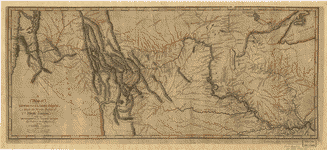
A Map of Lewis and Clark's Route,
Samuel Lewis, 1804-6.
Map Collections
While the 1832 arrival of the steamboat and the 1862 creation of the Homestead Act increased migration slightly, tension between the settlers and the Sioux discouraged potential newcomers. In 1868, the United States recognized the Black Hills as part of the Great Sioux Reservation, set aside for their exclusive use, by treaty. Nevertheless, with the 1874 discovery of gold, prospectors and the U.S. Army poured into the sacred Black Hills and onto the Sioux Reservation. In 1877, after armed resistance, the Sioux were forced to yield the Black Hills to the U.S. Government.
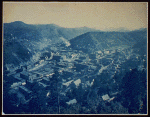
Deadwood, South Dakota,
a mining town born during the
Gold Rush, 1900.
Touring Turn-of-the-Century America: Photographs from the Detroit Publishing Company, 1880-1920
By 1881, even chief Sitting Bull had surrendered to Federal forces. Resolution of the Indian crisis and the completion of the Northern Pacific Railway combined to facilitate large-scale settlement of the area during the last decades of the 19th Century. Over 100,000 people migrated to North Dakota between 1879 and 1886.
From 1868 until the late 1880s, controversy over the location of the capitol divided citizens of Dakota Territory. Northerners named Bismarck their capitol in 1883, while Southerners created their own constitution that year selecting Pierre as the capitol. In February 1889, shortly before statehood was granted, congressional legislation officially divided the Territory.
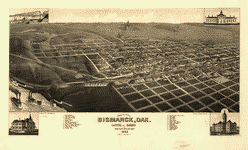
Bismarck, N.D.,
J.J. Stoner, Beck & Pauli lithographers, 1883.
Panoramic Maps
- See an Historical Overview of North Dakota in The Northern Great Plains, 1880-1920: Photographs from the Fred Hultstrand and F.A. Pazandak Photograph Collections. Also browse the collection to view a wide variety of North Dakota images such as, the 1908 picture Who Said You Couldn't Run a Car in the Winter Time?, and an image from the 1910s entitled Indians Traveling from Pembina, North Dakota to Fort Totten, North Dakota.
- Search on terms like Black Hills or Badlands in American Environmental Photographs, 1891-1936: Images from the University of Chicago Library to see images of the states' terrain. See, for example, Spearfish Falls in the Black Hills.
- Search on the term Dakota in History of the American West, 1860-1920: Photographs from the Collection of the Denver Public Library to see numerous images related to the area. This collection is particularly strong in images related to the Sioux people, and the U.S. soldiers who fought in the Black Hills. See, for example, Young Man Afraid Of His Horses, a Oglala Sioux on horseback near a group of tepees, and Gen. Cook's Army in Camp, on French Creek.
- Learn more about the Sioux in the Dakotas. Search the Today in History Archive on the term Sioux to see features such as The Wounded Knee Massacre.
- Search on the word Sioux in Edward S. Curtis's The North American Indian: Photographic Images for additional related images. See, for example, Ogalala War-Party or Brule War-Party, which each show a party of Sioux re-enacting a raid.
- Search on Dakota in the following collections to find a wide variety of additional materials on North and South Dakota:
Mary Todd Lincoln
All the distinguished in the land…would almost worship you if you would put a fighting general in the place of McClellan.Mary Todd Lincoln to Abraham Lincoln, November 2, 1862.
Words and Deeds in American History: Selected Documents Celebrating the Manuscript Division's First 100 Years
Mary Todd Lincoln corresponded with her husband on November 2, 1862, advising him of popular sentiment against the cautious commanding of general of the Army of the Potomac George B. McClellan.
McClellan had defeated the Confederates at the Battle of Antietam on September 17 but disappointed the president and the people of the Union by failing to take advantage of the victory by pursuing Robert E. Lee's weakened army. Earlier that year, McClellan had won a series of victories in the Peninsular Campaign which had brought Union troops within five miles of the then Confederate capitol, Richmond. Again, the general's hesitancy cost him the opportunity to take Richmond. Shortly after receiving this letter from Mrs. Lincoln, on November 5, the president removed McClellan from his command.
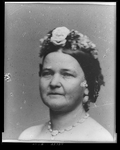
Mrs. Abraham Lincoln, between 1860 and 1865.
By Popular Demand: Portraits of the Presidents and First Ladies, 1789-Present
Abraham Lincoln's law partner (and biographer) William Herndon, whose memories of the president's young adulthood became an important source of information about Lincoln after his assassination, popularized the notion that the Lincoln’s marriage had been a failure. Lincoln's heart, Herndon alleged, belonged to Ann Rutledge whom young Lincoln had known in New Salem, Illinois. Most historians now agree that Mary Todd was the love of Abraham Lincoln's life and a source of strength and inspiration despite her occasionally erratic behavior during their years in the White House.
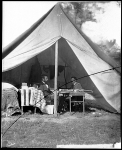
Antietam, Md. President Lincoln and Gen. George B. McClellan in the General's Tent,
Alexander Gardner, photographer, October 3, 1862.
Selected Civil War Photographs
- Words and Deeds in American History: Selected Documents Celebrating the Manuscript Division’s First 100 Years provides a glimpse into several important moments in the life of the sixteenth president, including a page of a sum book from his childhood, and a letter to Mary S. Owens, who received a proposal of marriage from Lincoln in 1837. Search the collection on Lincoln to find more material. To learn more about the Manuscript Division, visit the special presentation Collecting, Preserving, and Researching History: A Peek into the Library of Congress Manuscript Division.
- Visit Mr. Lincoln's Virtual Library, which highlights two Library of Congress collections and brings together the wealth of Lincoln materials including correspondence and papers accumulated primarily during Lincoln's presidency in forms such as prints, broadsides, books, pamphlets, sheet music, cartoons, maps, drawings, and other memorabilia that offer a unique view of Lincoln's life and times.
- Search Selected Civil War Photographs on George B. McClellan to find photographs of the general. Also search on Richmond to find many images of that city.
- Search on the keyword George B. McClellan in the Abraham Lincoln Papers to read a series of letters and telegrams sent by, to, and about the general in chief of the Union (or Federal) armies, who also served for a time as the commanding general of the Army of the Potomac. Also search on Herndon to view correspondence involving Lincoln, Herndon, and others.